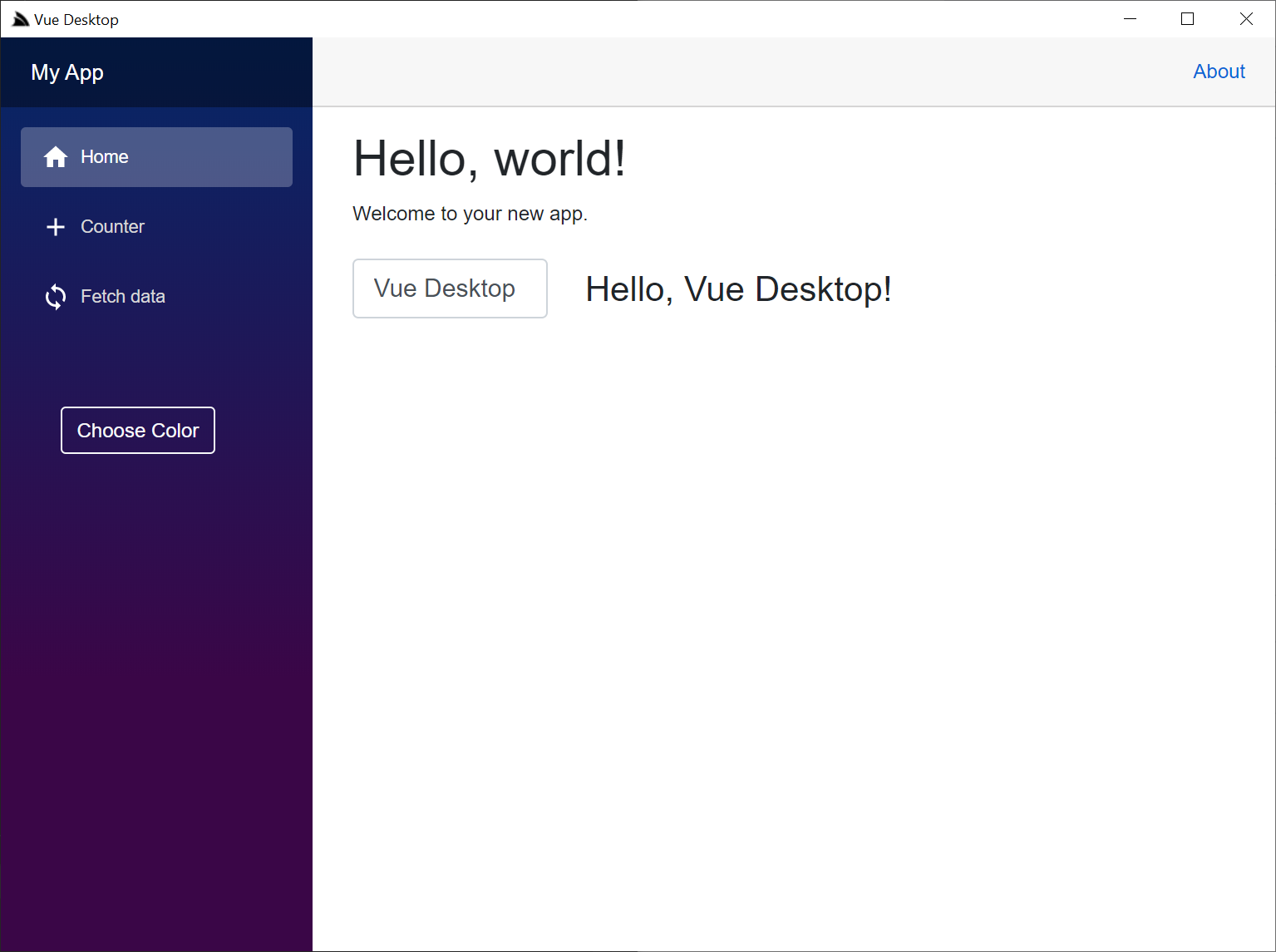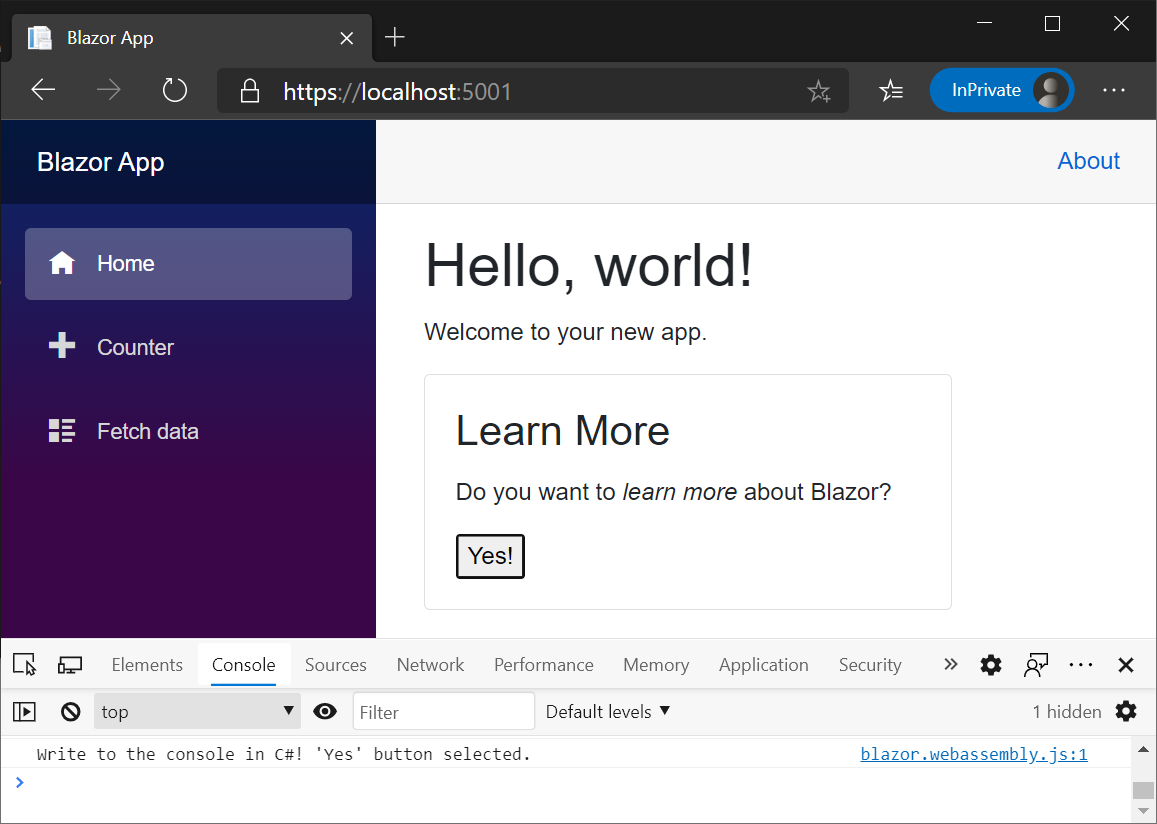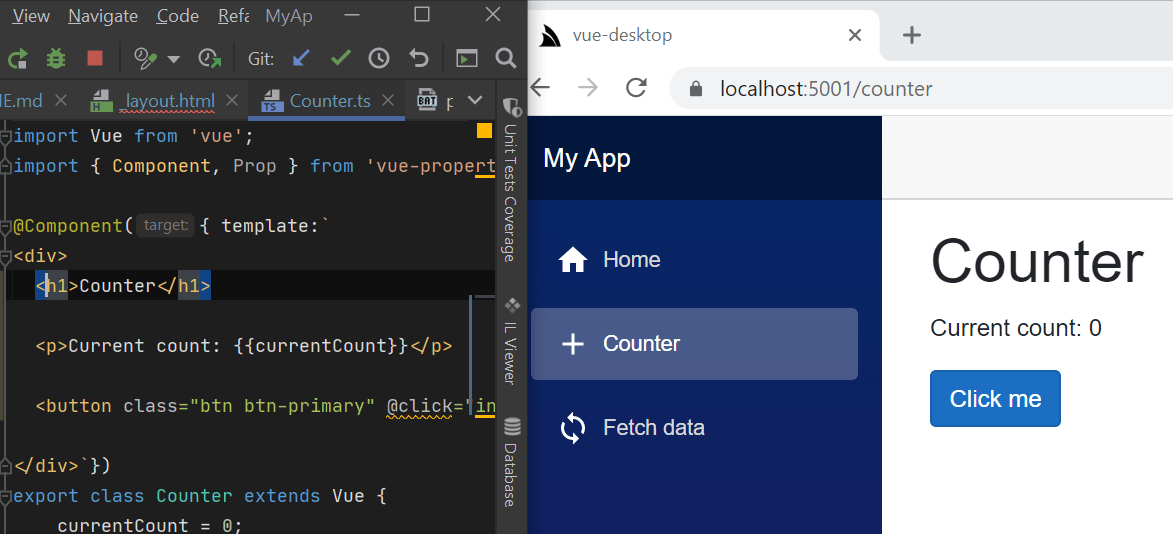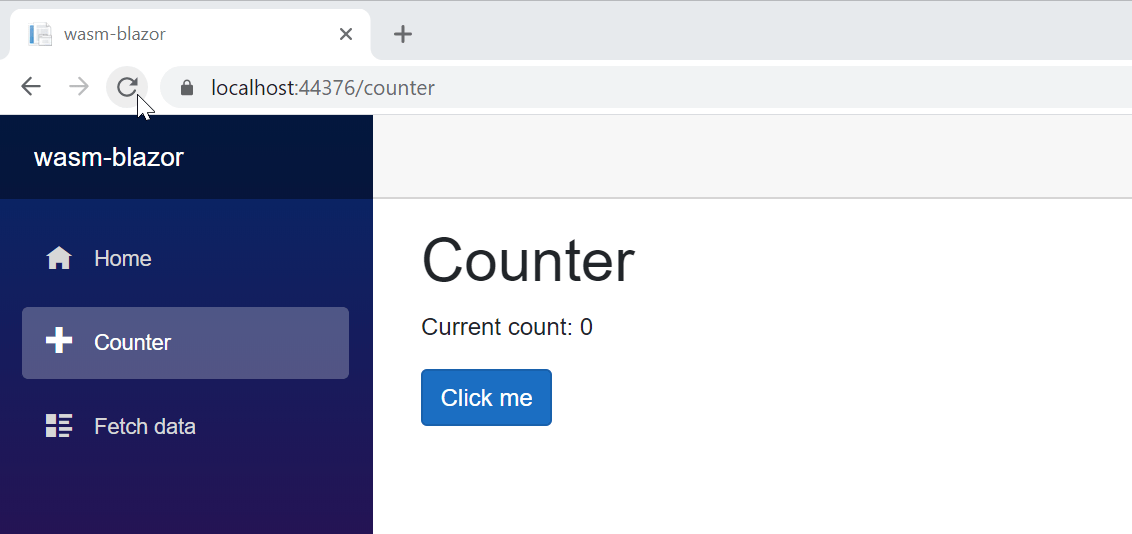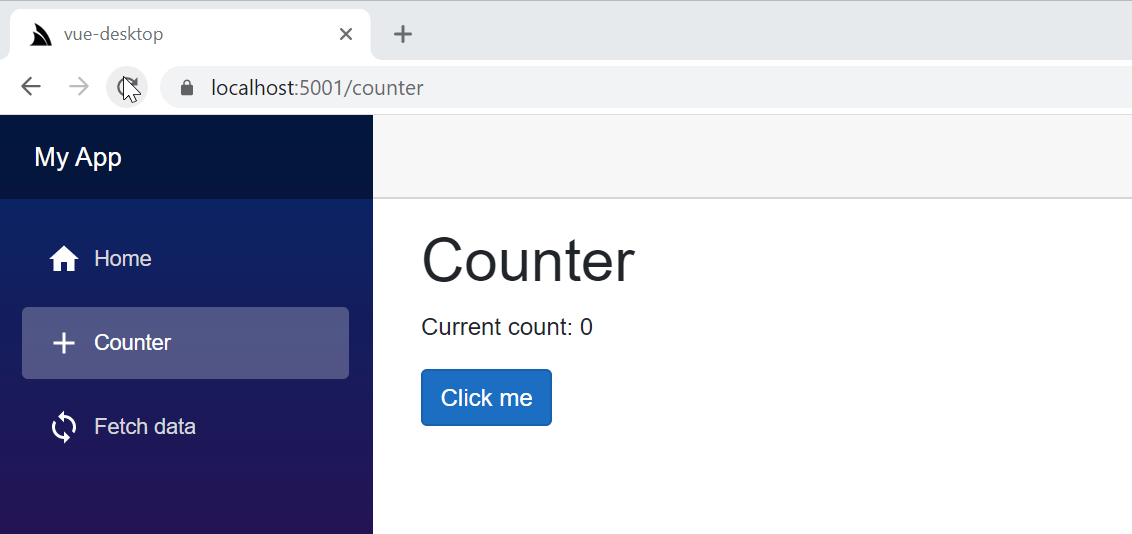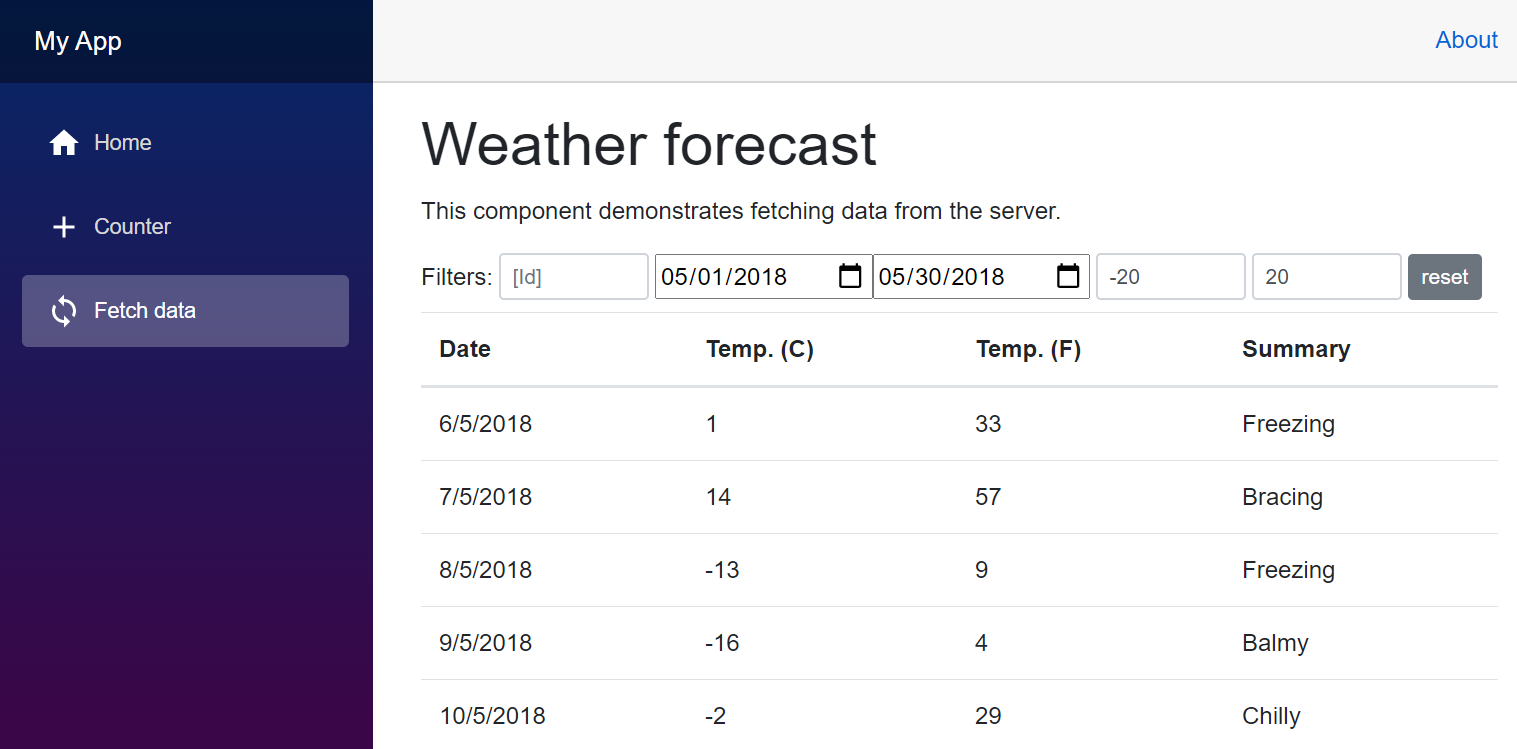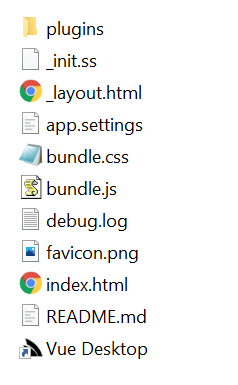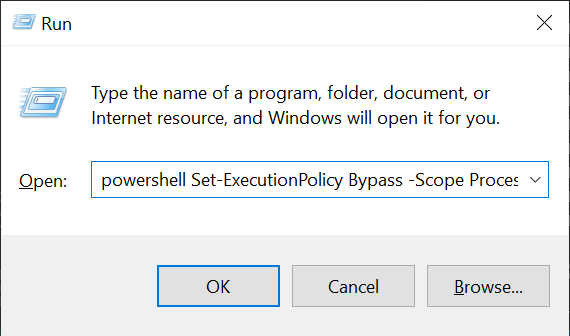vue-desktop
.NET 5.0 Vue Windows Desktop App Project Template.
This Project Template lets you create .NET Core Vue Single Page Apps that can also be packaged & deployed as Gist Desktop Apps which is ideal for quickly & effortlessly creating & deploying small to medium .NET Core Windows Desktop Apps packaged within a Chromium Web Vue UI within minutes!
Create new project with app dotnet tool:
$ dotnet tool install -g app
$ app new vue-desktop ProjectName
YouTube: youtu.be/kRnQSWdqH6U
Why Chromium Desktop Apps?
With the investment into advancing Web Browsers & Web technologies, many new modern Desktop Apps developed today like: Spotify, VS Code, GitHub Desktop, Skype, Slack, Discord, Whats App, Microsoft Teams, etc. are being built using Web Technologies and rendered with a Chromium webview, using either the popular Electron Framework or the Chromium Embedded Framework (CEF) directly.
Following VS Code frequent releases makes it clear why they've decided on developing it with Web Technologies using Electron where they've been able to iterate faster and ship new features at an unprecedented pace. In addition to its superior productivity, they're able to effortlessly support multiple Operating Systems as well as enable reuse for running on the Web as done with its Monaco Editor powering VS Code as well as innovative online solutions like GitHub Code Spaces.
These attributes in addition to the amount of investment that major technology companies like Google, Apple, Microsoft & Firefox invest each year in improving Web & browser technologies will ensure the platform will be continually supported & improved unlike most Desktop UI Technologies.
Comparison with Blazor WASM
What technology to use for Chromium Desktop Apps?
The latest solution for building Single Page Apps being promoted for .NET is https://blazor.net/ where for Client Apps suggests to use Blazor WASM which in an overview lets you run C# in the browser by running linked/tree-shaken .dll's in interpreted mode by the dotnet runtime which is itself compiled & running as WASM. We can see a glimpse of this in action by viewing .dll's being loaded in the JS Debug Inspector:
Disadvantages of Blazor
The main value proposition of Blazor appears to be running C# in the browser, which while a technically impressive feat, requires a tonne of complexity to achieve that results in worse end-user UX. It works using a development model based on Razor - a technology we're not fond of due to its reliance on heavy/complicated tooling and should be noted that historically whenever .NET invented their own development model for the Web in ASP.NET Web Forms or Silverlight, they've ended up being abandoned.
Another reason we're not fond of technologies like Blazor is from experience in having to support "crippled" .NET Runtimes on platforms where only a subset of functionality of .NET is available, where we've lost untold time & effort trying to diagnose & track down runtime issues in Windows Phone, Silverlight & Xamarin iOS due to platform restrictions (we're already seeing reported in Blazor), differing implementation behavior or .NET libraries heavy use of reflection that's problematic in AOT environments.
Even without the drawbacks, going against the momentum of established Web UI Technologies like Vue & React, their vibrant communities & awesome ecosystems in favor of an uncertain foreign development model reliant on heavy/complex tooling that only a single vendor can provide serving only a single language ecosystem just to be able to use C# in the browser isn't a desirable goal as modern JS/TypeScript offer a more productive & enjoyable Reactive UI development model than any C#/XAML UI Framework we've used.
Ultimately as staunch enemy's of complexity we're philosophically against reliance on heavy complicated tooling and instead have adopted a Vue Chromium Desktop approach for the development of ServiceStack Studio - an App that wouldn't have been feasible if needing to use any C# & XAML UI FX or WinForms historically used to develop .NET Desktop Apps.
Blazor WASM Starting Project Template
But as it's the latest technology developed & promoted by .NET PR it's going to be the Web UI technology compared to most, so this project template is based on the UI of an empty Blazor WASM project, rewritten to use Vue SPA UI & a back-end .NET Core App. It's an enhanced version that also includes examples of commonly useful features:
- Home page includes example of using TypeScript Service Reference to consume typed APIs
- Fetch data page sources it's data from an embedded SQLite database querying an AutoQuery Service
- Utilizes built-in SVG support for using Material Design & Custom SVG Icons
- Utilizes Win 32 Integration showcasing how to call Win32 APIs from the UI
Distributed App Size
The first comparison is a direct result of the approaches used in each technology, where in addition to all your App's
assets Blazor WASM has to also bundle a dotnet WASM runtime & linked/tree-shaken .dll's. Whilst app Desktop Apps
is on opposite side of the spectrum where it only requires distribution of App-specific functionality as all popular
Vue JS libraries, Bootstrap CSS, Material Design SVG icons or ServiceStack .dll's used are pre-bundled with the global app dotnet tool.
For the comparison we ran the publish-app script & Blazor's Publish to Folder tool & compared the .zip of each folder which resulted in:
15kb Vue Desktop App vs 6207kb Blazor WASM (413x smaller)
The end result that even our enhanced Blazor WASM starting project template is 413.8x or 2.6x orders of magnitude smaller than Blazor WASM. A more apt comparison of its tiny footprint, is the enhanced Vue Desktop App is over 4x smaller than Blazor WASM's 65kb partial screenshot of its App:
In addition, the app tool also bundles a Chromium Desktop App shell in order for your Vue Desktop Apps to appear like Native Desktop Apps,
to get the same experience with Blazor WASM App you would also need to manage the installation of a Chromium wrapper like
Chromely.
When App sizes are this small you have a lot more flexibility in how to distribute & manage the App, which is how Vue Desktop Apps can be published to Gists and always download & open the latest released version - enabling transparent updates by default.
Live Reload
A notable omission from a modern UI FX is there doesn't to be any kind of Live Reload capability for any page, including static .html or .css resources.
Vue Desktop Apps naive live reload feature works as you'd expect where the UI automatically refreshes on each file change, e.g:
This is a good example of why we prefer to avoid complex tooling as what's normally a trivially implementable feature requires much more effort & time to implement when you're reliant on a complex architecture & heavy tooling.
The only build tool required to enable Live Reload in Vue Desktop Apps is TypeScript's watch feature which monitors and automatically
transpiles all *.ts file changes:
$ tsc -w
Reload Time
The lack of a live reload feature is exacerbated when having to manually reload your App to view every change which has noticeable delay in Blazor WASM which is otherwise instant in a normal .NET Core Web App:
Blazor WASM
Vue Desktop
Opinionated App Launcher
The app dotnet tool is essentially just a .NET Core Desktop App launcher hosted within a Chromium Desktop Shell,
whether it's launching our app Desktop Apps or existing
.NET Core Web App .dll or .exe's.
It's opinionated in the shared libraries it includes, namely:
- Vue, React & jQuery
- Bootstrap CSS
- Material Design & Fontawesome SVG icons
- ServiceStack .NET Packages & Dependencies
You can use your own client/server libraries but they'd need to be distributed with the App
Intended for developing small/medium Desktop Apps that can be published to a GitHub Gist (or repo) & opened over a URL, e,g: Redis Admin UI, generic DB Viewer or our ServiceStack Studio API Management tool which all package down to small footprints.
Given you can build & distribute an App within minutes, it's suitable for quick UI's around a single purpose Task you may want to distribute internally, e.g. a dynamic reporting viewer, edit forms, surveys, email composer, or see the Desktop App Index for other examples.
FREE!
To remove friction & barriers to adoption all app and x dotnet tools used to run all Sharp and Gist Desktop Apps utilize an unrestricted suite of ServiceStack Software that can be developed & distributed free without a commercial license.
Alternative Modern Desktop Solutions
We don't recommend this template for flagships Desktop App worked on by large teams, in that case you're better off building your own custom Chromium Desktop App bundle as Spotify does where you're able to access full control over CEF APIs, it's rendering, integration and Chromium features. If you're looking looking to Chromotize a .NET Core Desktop App you can use our ServiceStack.CefGlue .NET Standard 2.0 NuGet package of the CefGlue C# CEF Bindings project.
If you're not using .NET Core, Electron is the most likely best choice for building Desktop Apps with Web Technologies.
If you'd also want to develop native iOS / Android Apps from a shared code-base then Flutter Desktop is looking like the most promising technology under active development in that space.
Overview of Gist Desktop Apps
Whilst on the face of it Gist Desktop Apps appear to be similar to Electron Apps that utilizes a .NET Core backend instead of Node.js, it employs a shared architecture where all Apps are run with the same app dotnet tool installable with:
$ dotnet tool install -g app
Where it enables a number of unique features:
Ultra Lightweight Desktop Apps
Unlike Electron which bundles Chromium with every install, all Sharp Desktop Apps utilize the same app dotnet tool which in addition to the latest version of Chromium, also includes many popular .NET server + client JS/CSS framework libraries - saving Vue Desktop Apps from having to include them. This effectively reducing their footprint to just App-specific Server + Client logic, so whilst a Hello World Electron App can require >100MB, this Vue Desktop Project Template bundles down to a 15kb .zip - which includes the 14kb uncompressed .NET Server .dll.
Launch Desktop Apps from URLs
Thanks to their light footprint Desktop Apps can be launched directly from URLs using the app:// URL Scheme, e.g.
a modified version of this Project Template can be launched from:
app://vuedesktop
Which uses the unique global alias your app was published with.
Deep Links
It's also possible to pass additional params to enable deep links into Apps ServiceStack Studio utilizes to be able download, run & immediately invoke App specific functionality like connecting to a remote site, e.g:
app://studio?connect=https://localhost:5001
Create customized Apps by mixing in Gists
Another unique feature of Gist Desktop Apps is being able to mix in multiple files into the App's directory to create custom App builds, e.g. the SharpData generic RDBMS UI viewer utilizes this feature to copy & immediately open an embedded SQLite database for querying:
- app://sharpdata?mix=northwind.sharpdata
- app://sharpdata?mix=chinook.sharpdata
Launch from public or private GitHub Repos
If preferred Desktop Apps can also be published & launched directly from your GitHub Repo which can be launched with app://{user}/{repo}, e.g`:
- app://sharp-apps/redis - Redis Admin App
- app://sharp-apps/blog - SQLite powered Blog App
- app://sharp-apps/spirals - SVG Spirals App
- app://sharp-apps/rockwind - Multi Layout CMS + DB Admin UI Example
Can open by pasting above links in browsers URL as GitHub doesn't render links with custom URL Schemes
If your repo has published releases it will use your most recent release, otherwise it uses the master archive.
Private Repos & Gists
Apps can also be launched from private Gists and Repos by either having end users configure the GitHub Access Token
with access to the private gist or repo in the GITHUB_TOKEN Environment variable or can be specified in the URL
or command-line with:
app://user/repo?token={GITHUB_TOKEN}
$ app open user/repo -token {GITHUB_TOKEN}
Copy Directory
Another way to distribute & run Apps is to XCOPY the /dist folder which users can launch by running app command in
the App's folder or by specifying the path to the app's app.settings, e.g:
$ app C:\path\to\app\app.settings
Where you can also create a Windows Shortcut for a more integrated Desktop App:
$ cd C:\path\to\app
$ app shortcut
Tip: Add
favicon.icoto use your own icon in the shortcut
Cross Platform Support
Whilst the app dotnet tool is Windows-only, all Sharp Apps can also be run cross-platform on macOS/Linux with the
x dotnet tool where it will open in the users preferred browser, e.g:
$ x open vuedesktop
Always uses latest version
Thanks to their tiny footprints the default behavior is to always download & run the latest version of the App when
published to a Gist or Repo which automatically happens when launching Apps using the app:// URL Scheme or app open command.
If preferred you can save 1-3 seconds on an App's launch time by using the app: URL scheme or app run command where
it will instead load the previously downloaded version, e.g:
app:vuedesktop
$ app run vuedesktop
Native Win32 API Interop
As #Script is a scripting language utilizing JS syntax to invoke .NET APIs, the Win 32 support ends up being both simple & intuitive.
Where it calls the CustomMethods.cs .NET Win 32 APIs
(wrapped in a #Script method) directly from JS as done in
App.ts which can be invoked using JS syntax
using the evaluateCode TypeScript API, e.g:
import { evaluateCode } from '@servicestack/desktop';
await evaluateCode(`chooseColor()`);
await evaluateCode(`chooseColor('#336699')`);The app dotnet tool already includes these dotnet/pinvoke .NET Wrapper API NuGet packages
below so they can be used within your App without needing to distribute them with your App:
<PackageReference Include="PInvoke.AdvApi32" Version="0.6.49" />
<PackageReference Include="PInvoke.BCrypt" Version="0.6.49" />
<PackageReference Include="PInvoke.Crypt32" Version="0.6.49" />
<PackageReference Include="PInvoke.DwmApi" Version="0.6.49" />
<PackageReference Include="PInvoke.Gdi32" Version="0.6.49" />
<PackageReference Include="PInvoke.Hid" Version="0.6.49" />
<PackageReference Include="PInvoke.Kernel32" Version="0.6.49" />
<PackageReference Include="PInvoke.Magnification" Version="0.6.49" />
<PackageReference Include="PInvoke.MSCorEE" Version="0.6.49" />
<PackageReference Include="PInvoke.Msi" Version="0.6.49" />
<PackageReference Include="PInvoke.Fusion" Version="0.6.49" />
<PackageReference Include="PInvoke.NCrypt" Version="0.6.49" />
<PackageReference Include="PInvoke.NetApi32" Version="0.6.49" />
<PackageReference Include="PInvoke.NTDll" Version="0.6.49" />
<PackageReference Include="PInvoke.Psapi" Version="0.6.49" />
<PackageReference Include="PInvoke.SetupApi" Version="0.6.49" />
<PackageReference Include="PInvoke.Shell32" Version="0.6.49" />
<PackageReference Include="PInvoke.SHCore" Version="0.6.49" />
<PackageReference Include="PInvoke.User32" Version="0.6.49" />
<PackageReference Include="PInvoke.Userenv" Version="0.6.49" />
<PackageReference Include="PInvoke.UxTheme" Version="0.6.49" />
<PackageReference Include="PInvoke.WtsApi32" Version="0.6.49" />See Win32 App for more info & examples on Win32 integration.
Desktop or Server Deployments
Whilst this project template is intended for creating Desktop Apps, it's essentially just a .NET Core Web App wrapped in a shared Chromium Desktop Shell which means it can also be deployed the same as any other .NET Core Web App by generating a published build:
$ dotnet publish -c Release
Then copying the published release builds for Server deployments.
Development Model
To avoid needing to use webpack, npm or any other build tooling, Vue components are written in TypeScript Class-Style Vue Components utilizing annotations in vue-class-component & vue-property-decorator, e.g. here's Blazor WASM Counter Page:
@page "/counter"
<h1>Counter</h1>
<p>Current count: @currentCount</p>
<button class="btn btn-primary" @onclick="IncrementCount">Click me</button>
@code {
private int currentCount = 0;
private void IncrementCount()
{
currentCount++;
}
}Written as a TypeScript Class-Style Vue Component:
@Component({ template:`
<div>
<h1>Counter</h1>
<p>Current count: {{currentCount}}</p>
<button class="btn btn-primary" @click="incrementCount()">Click me</button>
</div>`})
export class Counter extends Vue {
currentCount = 0;
incrementCount() {
this.currentCount++;
}
}Vue's integration with TypeScript is set to improve in Vue 3 which will be written in TypeScript
Typed DTOs
The typing benefits of C# is also available when using TypeScript with type definitions available for all libraries which provides rich intelli-sense & type checking during development.
Thanks to ServiceStack's Add TypeScript Reference
feature, Types are also available for your C# Services which can be updated by running
npm run dtos or app ts directly, e.g:
$ app ts
Which will update all dtos.ts TypeScript Reference DTOs with the latest changes which can be used together with the @servicestack/client generic Service Client to provide both a terse & typed API for consuming back-end end-to-end Typed C# APIs:
import { Hello } from "../shared/dtos";
import { client } from "../shared";
@Component({ template:`
<div>
<h1>Hello, world!</h1>
Welcome to your new app.
<div class="row mt-4 p-0">
<div class="col col-3">
<v-input placeholder="Your name" v-model="txtName" />
</div>
<h3 class="col col-5 result mt-2">{{ result }}</h3>
</div>
</div>`})
export class Home extends Vue {
public txtName: string = '';
public result: string = '';
@Watch('txtName')
async onNameChanged(value: string, oldValue: string) {
await this.nameChanged(value);
}
async nameChanged(name: string) {
if (name) {
const r = await client.get(new Hello({ name }));
this.result = r.result;
} else {
this.result = '';
}
}
}AutoQuery Services
Another major productivity boost for rapidly developing data-driven APIs is AutoQuery RDBMS where you can simply create queryable APIs by just declaratively defining which fields you want to query using any of the registered conventions, e.g:
[Route("/forecasts")]
[Route("/forecasts/{Id}")]
public class QueryWeatherForecasts : QueryDb<WeatherForecast>
{
public int? Id { get; set; }
public DateTime? BeforeDate { get; set; }
public DateTime? AfterDate { get; set; }
public int? BelowTemperatureC { get; set; }
public int? AboveTemperatureC { get; set; }
}
public class WeatherForecast
{
[AutoIncrement]
public int Id { get; set; }
public DateTime Date { get; set; }
public int TemperatureC { get; set; }
public string Summary { get; set; }
public int TemperatureF => 32 + (int)(TemperatureC / 0.5556);
}Which is all that's required for ServiceStack to automatically implement the Service where it has access to all standard Typed API metadata services like being included in the generated TypeScript client DTOs:
$ npm run dtos
Which FetchData.ts uses to power its
dynamic Queryable UI by sending a populated QueryWeatherForecasts Request DTO configured with any filters and re-executed
on every input change:
<form class="form-inline mb-2" @submit.prevent="">
<label for="txtId">Filters: </label>
<input class="form-control form-control-sm mx-1" type="number" placeholder="[Id]" v-model="id" @input="filter">
<input type="date" v-model="afterDate" @change="filter">
<input type="date" v-model="beforeDate" @change="filter">
<input class="form-control form-control-sm mx-1" type="number" placeholder="Above (C)" v-model="aboveTemp" @input="filter">
<input class="form-control form-control-sm mr-1" type="number" placeholder="Below (C)" v-model="belowTemp" @input="filter">
<button class="btn btn-secondary btn-sm" @click="reset">reset</button>
</form>Triggering a call to filter() to populate and resend the QueryWeatherForecasts Request DTO with the latest filters and update the forecasts Reactive UI Model:
export class FetchData extends Vue {
forecasts:WeatherForecast[]|null = null;
id = '';
beforeDate = '';
afterDate = '';
belowTemp = '';
aboveTemp = '';
async filter() {
const request = new QueryWeatherForecasts();
if (this.id) request.id = parseInt(this.id);
if (this.beforeDate) request.beforeDate = this.beforeDate;
if (this.afterDate) request.afterDate = this.afterDate;
if (this.belowTemp) request.belowTemperatureC = parseInt(this.belowTemp);
if (this.aboveTemp) request.aboveTemperatureC = parseInt(this.aboveTemp);
this.forecasts = (await client.get(request)).results;
}
}Publishing Desktop Apps
The lightweight footprint of Vue Desktop Apps allows for multiple deployment options, including:
- Publish to a Gist
- Publish to a GitHub Repo
- Publish to .zip and run with
apptool - Publish to self-contained .zip (bundled with app tool)
Our recommendation is to publish Sharp Desktop Apps to Gists (as done with ServiceStack Studio) so they can be launched with the Custom URL Scheme:
app://vuedesktop
Where it can be launched from a HTML <a/> link in a web page, directly in any browsers URL bar or File Explorer.
Desktop Apps published to GitHub repos can be opened using <user>/<repo>, e.g:
app://mythz/vuedesktop
Where it downloads & extracts the latest Release .zip archive (or master if none), before running the app, so can take a little longer to launch for small Apps.
All apps run the latest version by default so it's always up-to-date, but you can speed up App launch times by running the last installed app using the app: Custom URL Scheme:
app:vuedesktop
For Gist deployed Apps, it will run the last downloaded app or download & run the latest App gist if it's the first time it's run.
For GitHub repo Apps, you can download and install them locally with:
$ app install mythz/vuedesktop
Where the downloaded version can be run using its <repo> name, e.g:
app:vuedesktop
Both Gist and Desktop Apps can be uninstalled using app uninstall, e.g:
$ app uninstall vuedesktop
To view all installed Sharp Apps, run:
$ app uninstall
Creating Windows Shortcuts
The app: URL Scheme is a convenient way to launch Apps if you already have a Browser or Windows File Explorer already open where you can quickly launch Apps by typing CTRL+L shortcut to go to the Command Bar then type app://<name> to launch your App.
Although many users will prefer the familiar Windows Shortcut which they can create by going to the App's folder and running app shortcut
$ cd %USERPROFILE%\.sharp-apps\vuedesktop
$ app shortcut
This will create a Windows Shortcut for the App which can be copied to the Desktop or pinned to the Taskbar for easy access.
Publishing Gist Apps
Publishing your App to a gist is our preferred option as you can use GitHub to host your App, built-in auto-updates with every each launch and if you publish to the Global App Registry users can download & install your App with a unique UX-friendly name like app://vuedesktop.
To create gists you'll need to generate a GitHub Access Token with gist scope and add it to your GITHUB_TOKEN Environment Variable (win, mac, linux). (alternative: use -token arg in each publish command)
Before publishing your App, its app.settings looks something like:
debug true
name vuedesktop
CefConfig { width:1100, height:900 }
Publish to the Global App Registry
To maximize reach and accessibility of your App you can publish it to our Global App Registry by including the following metadata about your App:
appName <app alias> # required: alpha-numeric snake-case characters only, 30 chars max
description <app summary> # required: 20-150 chars
tags <app tags> # optional: space delimited, alpha-numeric snake-case, 3 tags max
The appName is the globally unique short alias you want your App to be launched as, e.g:
app://my-alias
$ app open my-alias
If your app.settings contains the app metadata above, publishing the app will publish your App to a Gist & register your App's alias to the Global App Directory.
Now you can build, bundle and publish your App to a gist with its publish-app npm script:
$ npm run publish-app
That returns the gist URL your app was published to:
published to: https://gist.github.com/gistlyn/48b2dcf9bccacab62ec9d8a073d5edb8
Which can now be opened via an URL scheme:
app://48b2dcf9bccacab62ec9d8a073d5edb8
Or via the command line:
$ app open 48b2dcf9bccacab62ec9d8a073d5edb8
When your App is published the first time, the created gist URL will be saved in a local .publish text file & used for subsequent App publishes.
Local Aliases
If the Gist App isn't published to the Global Registry, users can create their own UX-friendly local alias with:
$ app alias my-alias 48b2dcf9bccacab62ec9d8a073d5edb8
Where they'll be able to use their alias instead of the Gist Id:
app://my-alias
$ app open my-alias
Publishing to a GitHub Repo
The same /dist folder that's published to Gists can also be published to a GitHub Repo like github.com/mythz/vuedesktop which can be launched with the <user>/<repo> URL Scheme, e.g:
app://mythz/vuedesktop
Need to copy + paste URL in browser as GitHub markdown doesn't allow custom URL links
Or launched from the command-line:
$ app open mythz/vuedesktop
Users can also download and run a local copy launched with a Windows Shortcut with this 1-liner:
$ app download mythz/vuedesktop && cd vuedesktop && app shortcut
This will download this repo and create a Vue Desktop Windows Shortcut you can use to launch this App:
Publish to .zip
The /dist folder can also be zipped and distributed that way, by running:
$ npm run publish-zip
In which case it can be extracted and launched by running the app command in the App's folder:
$ cd AppDir
$ app
But if you're going to run from a local folder (where app:// isn't available), you'll likely want to create a Windows Shortcut:
$ app shortcut
That Users can copy to their Desktop or pin to their Taskbar for easy access.
Publishing self-encapsulated .zip
By having the app tool installed, users benefit from ultra small (e.g. 15kb) downloads whose tiny footprints allows for auto-updating with each App launch so they have access to new features as soon as they're available. Users will also be able to update to the Chromium version used to run all their Sharp Desktop Apps by updating the app tool:
$ dotnet tool update -g app
But if preferred, App's can also bundled and distributed with the app tool so they can be run without needing the app tool installed and distributed Apps are pinned to a specific Chromium version.
You can create self-encapsulated bundles with the publish-exe script:
$ npm run publish-exe
This will generate 2 files:
The *.zip contains both the /dist of your App and the app Chromium runtime as well as a convenience install.ps1 script that users can use to effortlessly install the App with the Win+R shortcut to bring up Windows Run dialog then pasting this powershell cmd-let with the URL of your install.ps1 script:
powershell Set-ExecutionPolicy Bypass -Scope Process -Force; iex ((New-Object System.Net.WebClient).DownloadString('https://org.example/install.ps1'))
Here's a copy of install.ps1 which downloads and extracts the App to the Users LocalApp Data and copies the Shortcut to the Desktop.
Before publishing you'll need to update $zipUrl to point to the URL with your *.zip:
$zipUrl = "https://org.example/MyApp.zip"
$appName = "MyApp"
$TempFile = New-TemporaryFile
Invoke-WebRequest $zipUrl -OutFile $TempFile
$Zip = "$(Join-Path $TempFile.Directory.FullName $TempFile.BaseName).zip"
Move-Item $TempFile $Zip
Remove-Item $(Join-Path $TempFile.Directory.FullName $TempFile.BaseName) -Recurse -ErrorAction Ignore
Expand-Archive -Force $Zip $(Join-Path $TempFile.Directory.FullName $TempFile.BaseName)
$AppDir = $(Get-ChildItem -Path $(Join-Path $TempFile.Directory.FullName $TempFile.BaseName) | Select-Object -First 1)
Remove-Item "$env:LOCALAPPDATA\$appName" -Recurse -ErrorAction Ignore
Move-Item $AppDir.FullName "$env:LOCALAPPDATA\$appName"
# Copy Shortcut to Desktop
Copy-Item $env:LOCALAPPDATA\$appName\dist\*.lnk -Destination $env:USERPROFILE\Desktop
# Clean up
Remove-Item $Zip -Recurse -ErrorAction Ignore
Remove-Item $(Join-Path $TempFile.Directory.FullName $TempFile.BaseName) -Recurse -ErrorAction IgnoreHere's an example of an app we have published to our servers:
powershell Set-ExecutionPolicy Bypass -Scope Process -Force; iex ((New-Object System.Net.WebClient).DownloadString('https://files.sharpscript.net/VueDesktop/install.ps1'))

